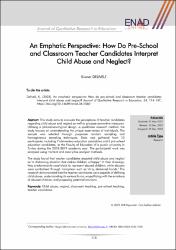An Emphatic Perspective: How Do Pre-School and Classroom Teacher Candidates Interpret Child Abuse and Neglect?
Citation
Journal of Qualitative Research in Education114An Emphatic Perspective: How Do Pre-School and Classroom Teacher Candidates Interpret Child Abuse and Neglect?Kismet DELIVELI*To cite this article:Deliveli, K.(2023). An emphatic perspective: How do pre-school and classroom teacher candidates interpret child abuse and neglect?Journal of Qualitative Research in Education,34, 114-147,https://doi.org/10.14689/enad.34.1560Abstract
This study aims to evaluate the perceptions of teacher candidates regarding child abuse and neglect as well as propose preventive measures. Utilizing a phenomenological design, a qualitative research method, the study focuses on understanding the unique experiences of individuals. The sample was selected through purposive random sampling and homogeneous sampling techniques. Data was gathered from 13 participants, including 7 elementary education candidates and 6 pre-school education candidates, at the Faculty of Education of a public university in Turkey during the 2018-2019 academic year. The participants' work was analyzed using "content and descriptive analysis" methods.The study found that teacher candidates depicted child abuse and neglect as "a distressing situation that makes children unhappy." In their drawings, they predominantly used black to represent abused children, while abusers were symbolized through metaphors such as "dirty, darkened hands." The research demonstrated that the teacher candidates were capable of defining child abuse, understanding its various forms, empathizing with the emotions of abused children, and proposing potential solutions.


















